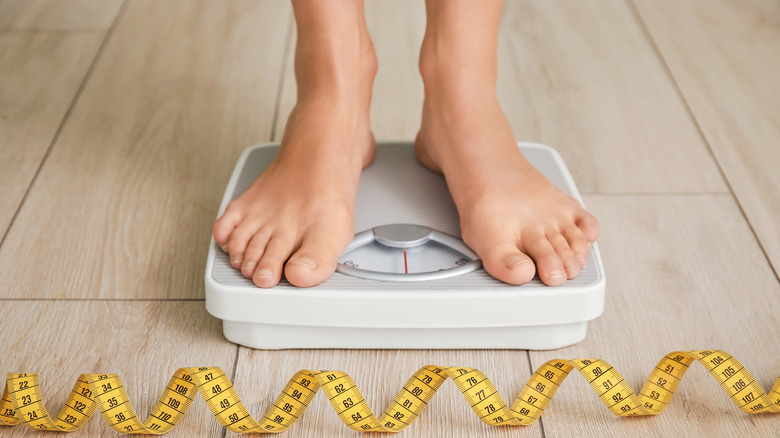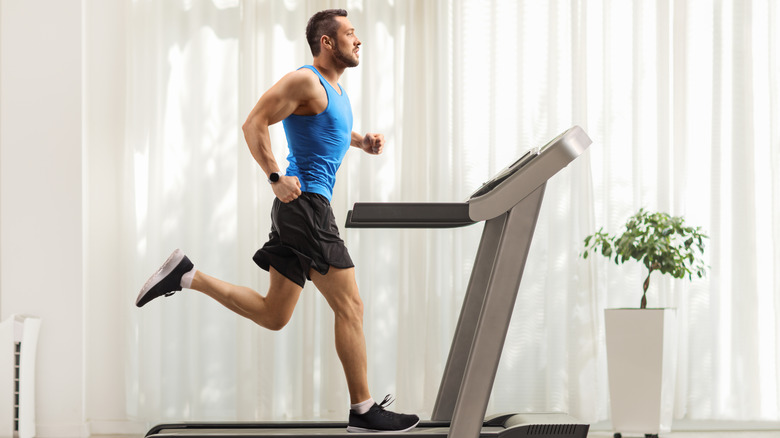Workouts That Will Seriously Burn Back Fat
Everyone has a "problem area" where they'd like to be a little leaner, and the back is a common one. For women, back fat can be especially unsightly when it leads to the dreaded "bra bulge."
Here's the bad news: There isn't any quick fix for it. No workout can specifically target your back for fat loss, because you can't spot reduce (via Yale Scientific).
Now for the good news: You can lose back fat by lowering your total body fat percentage through a healthy diet and regular exercise.
The best types of workouts to burn back fat are high-intensity cardio and strength training, which burn a lot of calories and boost your metabolism (via the University of New Mexico). Doing these types of workouts consistently and eating a calorie-controlled diet is your best bet for burning off back fat. If you're new to exercise, you can start gradually and build up the intensity and frequency of your workouts for excellent results. Here's a bunch of workouts that will burn fat throughout your body, including the back.
Fast facts about fat loss
Back fat has a number of causes, but generally it's due to an imbalance between the number of calories you eat and the number of calories you expend each day (via Scientific American). When you consume more calories than your body needs to support your daily physical activity, the excess is stored in fat cells. Over time, the store builds and you gain weight.
Genetics have a lot to do with where you store fat. Many people are genetically programmed to store fat around their midsection, while others see it more in their thighs (via Nature Communications). If your problem area is your back, you may be genetically predisposed to store fat in that area. Unfortunately, there's not much you can do about that.
And you can't target just your back for fat loss. The idea that you can burn fat from one area of your body with specific exercises is called spot-training or spot-reduction, and it's a myth. Fat loss doesn't work that way. To lose back fat, you have to lower your total body fat percentage. As you do that, you will see fat loss all over your body, including your back.
Keep in mind that exercise is only half the battle. Research shows that diet is just as important as exercise for losing fat and keeping it off (via Clinical Correlations).
Cardio vs. resistance training for fat loss
There are two main types of exercise — cardiovascular exercise, or "cardio," and resistance training. Cardio, such as swimming and running, primarily burns calories while you're doing it. For example, according to Harvard Health, the average-weight person will burn about 250 calories riding a stationary bike at a moderate pace for 30 minutes. Resistance training, such as lifting weights at the gym, burns fewer calories while you're doing it, but it's still crucial for back fat loss. Lean muscle mass is more metabolically active, because muscle requires more calories to build and maintain than fat. This means that building muscle has the potential to boost your metabolism 24 hours a day, not just when you're working out.
Therefore, the best workout for losing back fat will contain a combination of cardio and strength training. Not only is this the best workout combo for losing weight, but it's also the best for maintaining your overall health. Cardio improves respiratory and heart health, while resistance training builds strength, enhances balance and coordination, and improves bone health (via UW Medicine and Medicine and Science in Sports and Exercise). The Centers for Disease Control and Prevention (CDC) recommends adults engage in at least 150 minutes of moderate-intensity or 75 minutes of vigorous-intensity cardio exercise each week — and perform muscle-strengthening activities targeting all the major muscle groups on at least two days each week. But don't stop there. Exceeding those amounts will burn more fat and offer greater health benefits.
Steady-state cardio vs. interval training
It used to be thought that long bouts of low- to moderate-intensity cardio in the "fat-burning zone" was the best type of exercise for weight loss. But that's been debunked, reports The Washington Post. The new darling of the fat loss world is high-intensity interval training, or HIIT. HIIT involves alternating short intervals of intense exercise with periods of recovery. An example is running sprints.
According to the American Council on Exercise (ACE), HIIT trumps steady-state cardio for weight loss for a number of reasons. First, it's time efficient. You can burn the same amount of calories — or more — in a 20-minute HIIT workout as you could in a longer steady-state workout. Lack of time is a common reason for not exercising, so anything that gets results in less time is a big win. Secondly, HIIT is more fun. Because of its shorter duration and varied pace, it's a great option for people who easily become bored and distracted with longer continuous cardio workouts.
Physiologically, ACE reports that high-intensity exercise can stimulate the body to produce hormones that encourage muscle-building and fat-burning. And, it increases something called excess post-exercise oxygen consumption, or EPOC, which causes your body to continue burning calories after you've completed your workout.
This isn't to say that you can't do longer bouts of steady-state cardio if you want to, but including two or three HIIT workouts in your weekly routine will mix things up, allow you to get more done, and give your metabolism a boost.
Compound exercises are king
When you're lifting weights, you have a lot of exercises to choose from. If your goal is weight loss, however, you should opt for compound exercises. Compound exercises involve using more than one muscle group at a time — compared to isolation exercises, which work only one muscle or muscle group at a time (via the Columbia Association). For example, squats are a compound exercise, requiring activation of all the muscles in the lower body, whereas biceps curls are an isolation exercise, requiring the use of only one muscle group. The more muscle groups activated at one time, the more calories you'll burn during the exercise.
ACE recommends activating as many muscle groups at once by doing whole-body compound exercises, which combine two or more compound exercises into one. Examples include a squat thrust with plank rows and side lunge with overhead press. Other examples include burpees, squat thrusts, kettlebell swings, and mountain climbers (via Mark's Daily Apple).
High-intensity interval training workouts
It's easy to turn any steady-state cardio workout into an interval-training workout. All you have to do is break it up into periods of work and periods of recovery. In the beginning, start out with a shorter workout of 10 to 15 minutes. Because you're going to be working at a higher intensity than you would in a steady state cardio workout, it's best to ease into it so you don't risk injuring yourself.
Here's a sample treadmill interval workout from ACE: Start with a five-minute fast walk to warm up. Never skip the warm up! It primes your muscles for greater intensity and can prevent sports-related injuries, according to a 2022 research review in Cureus. Next, increase the incline to 5% and walk/jog for two minutes. Aim for a perceived rate of exertion (PRE) of about eight to nine. On a scale of one to 10, eight or nine is very challenging (via the Cleveland Clinic).
At minute eight, drop the incline to 2% and recover at an RPE of four to five for one minute. Minute nine to 10, increase the incline to 7%, and then lower it to 2% to recover for one minute. Next, raise the incline to 9% for one minute, then lower it to 2% for one minute of recovery. This is a good stopping point for a beginner workout, but you could keep going, raising the incline by 2% for each work interval. End your workout with a five-minute cool down at 0% incline.
Circuit-training workouts
Circuit training is similar to HIIT training in that it involves periods of work and rest, but it's different in that it includes resistance training, and the recovery periods are generally much shorter (via NASM). The benefit of this is that your heart rate remains elevated for the entire workout for maximum calorie burn. According to a 2018 study in Journal of Exercise Rehabilitation, a 12-week circuit training program significantly reduced body fat percentage in a group of 20 participants.
A circuit training workout can contain any combination of exercises. Typically these workouts are full body, targeting all the major muscle groups in one workout. But they may also focus on upper or lower body. Here's a sample circuit workout from Anytime Fitness to try: Start with a three to five-minute warm up. This could be jumping rope or doing jumping jacks. Next, do each of the following exercises for 60 seconds, resting 15 to 30 seconds in between each exercise: Step-ups, bent-over rows, bodyweight squats, shoulder presses, jumping jacks, Russian deadlifts, push-ups, glute-bridges, triceps dips, and plank holds.
Do as many reps as you can in one minute, but feel free to take breaks as needed. Start with one round, and as you get stronger you can add more rounds.
Best back exercises for definition
Remember that you can't spot train. You can do all the back workouts you want and build a lot of muscle, but if you don't reduce total body fat percentage, you'll still have back fat — because fat doesn't turn into muscle. The best way to burn back fat is to work on building overall lean muscle mass, which will help you burn more calories. Plus, only doing back exercises can lead to muscular imbalances in which your chest muscles become weakened (via Strong Links). That's not the look you're going for.
The best exercises for building back muscle, according to a 2018 study by ACE researchers, include: lat pull-downs, seated rows, bent-over rows, inverted rows, pull ups, chin ups, and I-Y-T raises. There was no single exercise that worked all of the muscles in the back; each of these exercises was best at activating different muscles throughout the back. So, it's best to include a variety of these back exercises in your workouts.
Other types of exercise to burn calories
The truth is that the best workout to torch back fat is one that you enjoy and will want to keep doing on a regular basis. If you've tried HIIT workouts and they're just not for you, no problem. The key is to stay active and challenge your body with moderate- to vigorous-intensity activities that burn calories and build muscle. So what do you like to do? If you love nature, then hiking is a great option. According to estimates from Harvard Health, an average-weight person can burn 267 calories hiking for an hour on flat terrain. If you're hiking uphill, you can burn considerable more calories and build some solid leg muscle (via Healthline).
Rock climbing and roller blading are some other fun options to try if you like being outdoors. A person of average weight can burn 281 calories rock climbing for an hour and up to 420 calories roller blading, depending on your speed (per Harvard Medical School). Of course, these are just estimates. According to MD Anderson Cancer Center, how many calories you'll burn depends on many different factors including the intensity at which you perform the activity, your body weight, and the amount of muscle mass you have (because muscle burns more calories than fat).
How to get started
It's important to start slow and work up to exercising at a more vigorous intensity. Jumping into high-intensity exercise too quickly can lead to injury. Beachbody Super Trainer Joel Freeman told MyFitnessPal that he recommends starting with no more than three HIIT sessions per week on alternating days. It's important to leave enough time between workouts for your body to recover. Doing too many high-intensity workouts in a row doesn't allow your body time to repair itself, and repeated inadequate recoveries can lead to injury and overtraining. It's great to be enthusiastic when you're first starting a new workout routine, but don't go overboard. More isn't always better.
Although you can do HIIT and circuit training anywhere, even at home, it's a good idea to get some guidance when you're starting out. You can typically find classes in most major cities. Check out your local gym or fitness studios in your area. You could also schedule a couple of sessions with a personal trainer to help you zero in on your goals and teach you some moves that you can do in your at-home workouts.
Don't forget your diet
Perhaps you've heard the expression, "Abs are made in the kitchen." The same is true for a lean, toned back. No matter how much you work out, if your diet is unhealthy or too high in calories, you won't lose back fat.
Knowing just how many calories you should be eating can be confusing. You don't want to take in more than you need, but you also don't want to take in too few calories. At best, this can leave you feeling too tired to work out; at worst, it can cause your metabolism to slow because your body goes into starvation mode to preserve energy (via Academy of Nutrition and Dietetics). According to the USDA's Dietary Guidelines for Americans, 2020-2025, adult males need 2,200 to 3,000 calories daily, depending on age and activity level. Adult females need 1,600 to 2,200 calories daily, depending on age and activity level.
But counting calories is no fun, and it isn't effective for long-term weight loss (via TIME). A better way to go is to simply follow a healthy diet, limiting certain foods and eating more of others. UCSF Health recommends limiting your intake of candy, honey, sugar, syrups, baked goods, and sodas — and cutting down on fatty foods such as bacon, sausage, and lunchmeat; fried foods; high-fat sauces; and butter and mayo. Instead, focus on eating lots of fresh fruit and vegetables; lean meats like chicken and fish; whole-grain breads, pasta and rice; and low-fat dairy.
Other lifestyle changes for weight loss
In addition to exercising more and eating healthier, there are a few other lifestyle changes you can make that will help you lose weight for a leaner back. Getting sufficient sleep is crucial. Not getting enough sleep can leave you too tired to hit your workout in the morning or at the end of the day. Lack of sleep can also increase cravings for unhealthy foods and cause you to over eat (via Sleep Foundation). It can also negatively affect your metabolism, according to an 2014 article in Current Diabetes Reports.
Hydration is another biggie. Even slight dehydration can cause fatigue and cause you to crave sugar, according to the Cleveland Clinic. And drinking water can stimulate your metabolism and naturally suppress your appetite (per John's Hopkins University). According to a 2009 article in Physiology & Behavior many people mistake thirst for hunger due to weak thirst signals. That means that even though you feel hungry, what you may actually need is a tall glass of water to feel satiated.
Reducing your stress level can also help you lose body fat. Long-term stress affects hormone levels related to metabolism and appetite. For example, elevated cortisol levels can affect glucose (blood sugar) control and lead to spikes and drops in energy and food cravings (via NASM). Ghrelin, the "hunger hormone," sends hunger cues to the brain when it is time to eat. In times of elevated stress, ghrelin levels are elevated, leading to overeating.
How to maintain weight loss long term
Once you've gotten the toned back of your dreams, you'll want to keep it that way. Unfortunately, maintaining weight loss can be challenging. It's too easy to go back to your normal eating and exercise habits once you reach your goal weight, so you must remain conscious of that. Losing weight isn't just something you do once; weight maintenance is a lifelong commitment. That sounds stressful, but when you think about the benefits of staying at a healthy weight, including a lower risk of several chronic diseases, it's well worth it (via the American Heart Association).
According to Columbia University Irving Medical Center, people who successfully maintain long-term weight loss have a few things in common. The majority of them stick to healthy habits such as eating breakfast each day, weighing themselves weekly, watching less TV, and exercising an average of one hour per day. Some tips for maintaining weight loss include identifying your triggers for overeating or skipping exercise so you can nip them in the bud, learning from others who have successfully kept weight off, having a network of family and friends who support your healthy habits, finding ways to motivate yourself to maintain healthy habits, and holding yourself accountable (per the American Heart Association).













